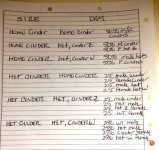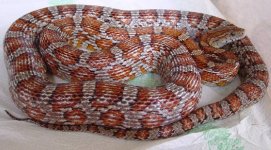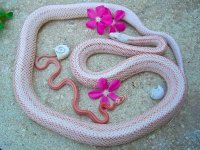Ok so here goes...
As stated above, it appears that some female het cinders throw all males, some throw all females (this seems less common), and some seem to have no trouble throwing either.
To explain this, I need to introduce the concept of genetic linkage. Imagine we have a snake that is homozygous for two recessive mutations we'll just refer to as Tender and Kisses (don't ask). We mate this snake to a wild type female to make babies that are het Tender het Kisses. We then mate these babies together. We would expect to get the classic 9:3:3:1 ratio of 3/16 Tender, 3/16 Kisses, 9/16 normal, and 1/16 Tender Kisses, correct?
Well, it turns out that we get 1/4 Tender Kisses and 3/4 normal. What? That 3:1 ratio is the ratio we'd expect if we were working with a single gene, not two genes! This is where linkage comes in.
These ratios we use on programs like corn calc assume that two mutant alleles like stripe and amel assort independently during meiosis so that the inheritance of one allele does not affect the inheritance of the other. This is true if the mutations are on different chromosomes, say chromosome 3 and 5. But what if the mutations are on the same chromosome? If mutations Tender and Kisses are on the same chromosome (let's use 9) they will always be inherited together unless a crossover occurs between them and separates them. In a het, this would create one chromosome 9 that has the Tender mutation on it on it but is wild type for Kisses, and the other chromosome 9 would be wild type for Tender and have the Kisses mutation. However, if crossover does not ever occur and they are always inherited together as a single unit, this would create the 1/4 Tender Kisses 3/4 normal ratio we saw.
If genes are really far apart on the same chromosome, they act like they are on different chromosomes because of the odds of single/double/triple crossovers occuring between them.
However, if two mutations are on the same chromosome and are far apart, there are factors that can still cause them to be inherited together. Large inversions on one of the chromosomes in the pair can suppress crossing over, causing the mutations to stay linked. However, this doesn't affect whether males or females are the ones who inherit the mutations together. Unless the mutations are on sex chromosomes.
This brings me back to cinder. I am reversing my earlier theory that crossovers between the cinder alleles on the Z and W chromosomes are rare! Instead, I think they are common! For reasons I won't go into, the recombination frequency between genes that are far apart on the same chromosome is 50%. I think the cinder locus is thus located on a large region of similarity between the Z and W chromosomes and thus experiences a 50% recombination rate, which is indistinguishable from independent assortment. However, I think that in CERTAIN lines of females, there may be an inversion or some other factor on the Z or W chromosome that is SUPPRESSING crossovers in these females. This prevention of a crossover will keep the cinder allele on the Z or W chromosome and skew the sex ratio of homo cinder offspring. This suppression is not 100% but is still very high.
This may sound wild but as a geneticist it makes perfect sense to me. It does make a prediction. A het cinder female who is throwing male cinders should do so in every clutch. A het cinder female throwing female cinders should continue to do so in every clutch. Because the crossover suppression is not 100%, there should be rare exceptions, but the pattern should stay the same for each individual het female. A het cinder female who makes male and female cinders should also continue to do so in future clutches.
If the inversion is on the Z chromosome, note that suppression of a crossover still has no effect in the sire. Assume he is het cinder. Since he is Z Z, a crossover can swap a cinder mutation from one Z chromosome to the other but the result on reproduction will not be different than if a crossover did not occur. A het cinder male has to give one of his Z chromosomes to both his male and female offspring. Whether or not crossover occurs, he would have 50% wt Z sperm and 50% cinder Z sperm.
What will be interesting is whether the suppressor of crossing over is on the Z chromosome. This is a disturbing possibility as male cinders/het cinders could pass this on to their daughters and cause them to have suppressed crossovers when producing offspring. Hopefully the suppressor of crossing over is on the W chromosome and hopefully the rare crossovers do not also encompass the suppressor of crossing over and move it to the Z chromosome in some individuals!!!
Again, this may sound crazy, but in the lab we actually take advantage of crossover suppression. Sometimes we want to make double or triple mutants of say, a fly. If the mutations are on the same chromosome we want them to be inherited together to increase our odds of recovering double and triple mutants when mating to another het. We use so-called "balancer" chromosomes that contain large inversions and suppress crossing over when they pair to the mutant chromosome, thus keeping all the mutant alleles together in a gamete.
Have I confused everyone yet?



